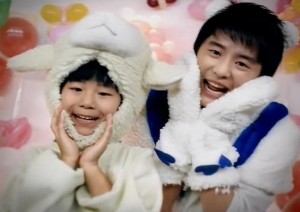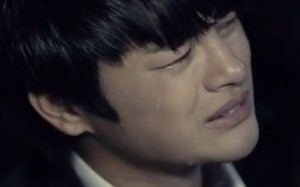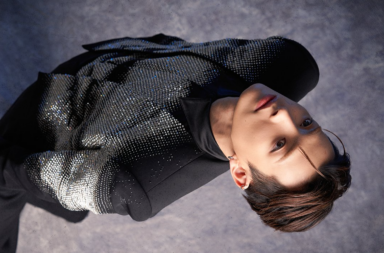 Korean pop music has predominantly been identified through brightly colored, diabolically sweet, and epilepsy-inducing music videos. From DB5K’s “Balloons” all the way to “Gangnam Style,” you cannot argue that K-pop isn’t fun.
Korean pop music has predominantly been identified through brightly colored, diabolically sweet, and epilepsy-inducing music videos. From DB5K’s “Balloons” all the way to “Gangnam Style,” you cannot argue that K-pop isn’t fun.
In spite of that, you also can’t say that K-pop is all fun and games either. Korean music warrants diversity, and what better place to show differences in ideologies, opinions, and points of view than a music video? The music industry is thriving in South Korea, and the “MV” stands to be a crucial vessel in which ideas are shipped across the airwaves. The aim is to use visual artistic expression (via video) to portray a story, evoking specific emotions in the audience watching, to a background of music. The popularity of such a practice has resulted in many an evolution taking place within this creative bubble.
The traditional box MV format has largely become obsolete, and newer cinematography has filled the vacuum such primitive techniques left behind. As a result, the music videos tackling many serious, unpopular, but nevertheless important issues have been attracting the glare of publicity in recent times.
Boasting an arsenal of cinematic trickery, each music video below tells a story and does it oh-so-well.
The Love Triangle – K.Will “Please Don’t”
[youtube=https://www.youtube.com/watch?v=PdUiCJnRptk]The plot is seemingly simple at first: it’s a love triangle in which we assume that Seo In-guk‘s character is in love with a girl (Dasom) who is in love with his best friend. The somber ambience is put in place when the first few bars of the song is played, and we viewers know that this is about to get real sad real fast.
What’s frustrating is that these somber, colourless scenes are interspersed with brighter flashbacks of happier times. The viewer at this point assumes the entirety of the situation and starts to feel a lot of empathy with In-guk’s character. This is further heightened when the wedding revelation occurs.
 This MV is all about increasing intensity — as the end of the MV comes nearer, the shots of the protagonist losing it become more and more frequent. He’s crying in the car, slapping the wheel, and his expressions get darker as his facade is slowly slipping away.
This MV is all about increasing intensity — as the end of the MV comes nearer, the shots of the protagonist losing it become more and more frequent. He’s crying in the car, slapping the wheel, and his expressions get darker as his facade is slowly slipping away.
The juxtaposition of him displaying calm and thoughtful conduct (however still intense) in the breaks of his meltdown are cause for confusion at this point of the MV. This is further deepened when the girl disappears from the car altogether. Is he really confessing to the girl? Did she find out?! What’s happening?! Oh God! The director’s decision is to purposefully overwhelm us, and K.Will screaming out “Don’t Go, please!” at the top of his lungs engulfs the viewer in the lead’s desperation. Soon enough, we too are pleading along with him.
This is important, as the final revelation of the protagonist’s true preference in the triangle leaves us speechless. Walking away from the screen, the viewer experiences an “a-ha!” moment mixed with embarrassment at our closed-mindedness and incompetence at not figuring it all out from the beginning. The director brings it all full circle by leaving us feeling dejected and hopeless in the end — much like how In-guk must be feeling.
Aside from this, some could argue that the MV’s true aim is to make social commentary about the homophobic culture that exists in South Korea. The relationship’s true nature is masked until the very end, until we have vested all our feelings into it. Once we find out, it causes us to question our own stereotypes of what a relationship is, who it involves, who it excludes, and whether our assumptions are wrong. The director in this situation has true mastery of their viewership, making this MV leave a lasting impact on our consciousness. Its aim is not only to make us think but to make us feel devastated that we cannot easily accept people for who they truly are.
The Dysfunctional Relationship – Ga-in’s “Fxxk U”
[youtube=https://www.youtube.com/watch?v=VSAVsstaj4E]When first watching this MV, I had a hard time keeping my eyes on the screen. Some scenes were loaded with such intensity that it was hard to be comfortable. After a little pondering, I gathered that this was the exact reaction that the MV was supposed to elicit from its viewers. The context of the video is seemingly apparent in the beginning: an abusive relationship wherein the male asserts his power over the woman through coercive sex.
It’s the little things, however, that make this MV. The dark colour palette exaggerates the dull and gloomy aura, forcing the viewers to imagine how horrible life must be living in such a house. Ga-in’s own black clothes contrast heavily with her bright red, bitten lips and pale skin. The imagery associates her with a Snow White persona, highlighting her innocence in the entire matter. For all we see, she is truly the victim.
In fact, the only vivid colour present in the MV is Joo Ji-hoon’s dirty yellow suit. He is an impeccably dressed alpha male with perfectly slicked hair, giving off a feeling of sobriety and a well-groomed persona, but the blandness of his suit says otherwise. Though the climax is uncertain — Does he rape her? Does she kill him? — an interesting image is shown to the viewer: him lying with his head in her lap, clearly in despair. Is he despairing about his actions? The lack of vibrance in the colour of his suit mirrors his lack of potency in the situation. His powerlessness is a strange concept for the viewer to grasp. How can he be without power? He’s the abuser!
There are many interpretations for his character, such as he’s emotionally blackmailing her into being with him, using his sadness and preying on her maternal instinct (seeing as she is content — albeit unenthusiastic — about laying him in her lap) to get what he wants. He dresses well and sober to show her that he feels sorry, he will change, he has changed. But to the viewer who see him abuse Ga-in consistently, it strikes us as nothing more than manipulation on his part.
But the contrast of the harsh image of the male and the soft crooning of Bumkey plays havoc on our opinion him. It doesn’t help that he’s cradling Ga-in near the end. Though, the fact that they are drenched in petrol playing with a match — obviously pertaining to how she stays with him because he gives her no other options — provides us some relief in asserting our opinions as him being the bad guy.
Upon further reflection, a newer interpretation may arise: it’s difficult to decide whether anyone really is in the wrong here. Relationships are complex; showing a hopeless man repenting on the ground unveils an idea: people do bad things and feel even worse after. But should this excuse the actions of someone who falls back into this cycle of abuse? Our empathy for his remorse may never render fruit. It begs the question of if an abuser accepts his wrong doing, does it make sense to trust them once more? In light of this, the viewer either feels distraught at the abuser’s inability to get out of this cycle or disgusted that they engage in it in the first place.
Either way, we are inclined to make a decision on whether or not to sympathise with this guy. Whether or not to take his side after watching his treatment of Ga-in. These questions leave you restless and saddened long after you finish watching the MV.
The Cliff Hanger – Nell “The Day Before”
[youtube=https://www.youtube.com/watch?v=a6AzbOupbxk]This MV doesn’t have a particular concept — it’s just a slow and steady culmination of sadness. The plot isn’t easy to pinpoint, unlike that of either of the previously mentioned MVs. It starts ambiguous and remains that way until the very end and for long after. The MV starts off with one male setting up a video camera for what seems to be an interview with another male.
The cinematography in this video is mind-blowing; as soon as the songs starts, everything slows down. You continue to watch the rest of video at this crawling pace, which forces you to take more things in and mull them over. The initiation of a thinking process is vital as the MV is pretty open-ended with its conclusion, compelling you to continue the process even after the MV finishes.
 The lyrics do very little to help us understand exactly what is going on. Is it a breakup? A suicide? A death? This coupled with the somber mood of the overall video propped up against shots of the actors laughing charmingly confuses the viewer. The situation is frustrating; you don’t know what is going on, but something is about to happen, and it’s going to affect us.
The lyrics do very little to help us understand exactly what is going on. Is it a breakup? A suicide? A death? This coupled with the somber mood of the overall video propped up against shots of the actors laughing charmingly confuses the viewer. The situation is frustrating; you don’t know what is going on, but something is about to happen, and it’s going to affect us.
The use of the Americano is interesting; such a “sophisticated” drink hinting at an adult theme establishes from the opening that this is not your average MV about the innocence of first loves. Shots of half-finished food symbolise unsaid words; a dying flower as it rots, decays and ages is reminiscent of something that was once beautiful; and inanimate objects exemplify death. The viewer somehow understands that though the MV shows casual chatter between two friends/lovers (we are not sure), we are in the throes of mourning.
Though the lyrics may be ambiguous, they are the driving force of the video. Kim Jong-wan sings “what’s the use of holding on to something that is scattering” just as a messy table is shown. Not long after, the visuals depict the shifting of conversation from something lighthearted to something more serious, a turn of events. “I wonder if we’re sometimes standing in the same memory” is hummed as one actor starts pouring poison. The concept of the video becomes clearer upon this revelation, recounting the death of a loved one consistently, and the significance of the camera comes to light as a playback device.
Once the MV comes to a close, the remaining male is motionless. We quickly come to realise that what is the most despairing element in the entire video is that he feels unable to do anything in the face of his friend’s death. He is unable to stop him dying, unable to save him, unable to speak his heart, but more importantly he is unable to start over.
Sadness is explored in many different ways in the above music videos. Whether it’s through showing a despairing love triangle, a frightening look at the dynamics between an abuser and the abused, or through seeing someone unable to cope with death, the true triumph of these videos is that they elicit fear, sadness, and despair from us.
And on that note, let us look forward to a future of perfectly orchestrated, death-inducing, and beautiful music videos. It’s high time that K-pop ransacked the attic of music videos that have been and gave it a good old spring cleaning. The MV revolution is upon us, and creative content galore will grace our computer screens (at varying speeds depending on your Internet service provider) for many years to come.
(YouTube [1][2][3], Images via Woollim Entertainment, 1theK, Starship Entertainment, SM Entertainment)




